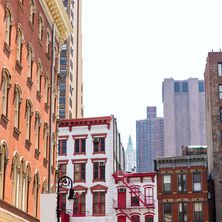

Soho is a particular name. Although it immediately makes one think of the Soho neighborhood in London, in New York the neighborhood derives its name from a report prepared by urban planner, Chester Rapkin. The report was titled The South Houston Industrial Area, and so the name of the area located below Houston Street was called Soho, short for south of Houston.
Soho actually inspired other Manhattan neighborhoods to abbreviate their names. There is Noho, which stands for north of Houston. There is Tribeca, which is a composite of the first letters of the words Triangle Below Canal Street. And there is also the humorous DUMBO, which stands for Down Under the Manhattan Bridge Overpass.
The neighborhood is framed by Houston Street in the north, Canal Street in the south, Sixth Avenue in the west and Crosby Street in the east. It consists of 26 blocks and over 500 buildings.
During the American Revolutionary War several fortifications were built on the farmland where the neighborhood lies today. However, none of them saw any military action because New York had never been a battleground in the military conflict. As New York began to expand and accumulate capital in the 19th century, Soho became an energetic zone filled with small manufacturing companies, metalworkers, carpenters, glassmakers and book publishers. The neighborhood was also a thriving nightlife hub with theaters, concert halls and brothels.
In the 19th century Soho also witnessed the construction of important architectural projects, particularly in the cast-iron material. At the time cast-iron was cheaper to use for facades than brick or stone, while steel was still not being used for buildings. The pliability of the material, especially for what regarded ornamental details, and its capacity to be easily recast made construction quick and convenient. The building design was based on classical European architecture, but the unconventionality of the texture added a modern touch. One of the most famous cast-iron buildings in Soho is the E.V. Haughwout Building on the corner of Broadway and Broom Street, which was styled after the Jacopo Sansovino's Marciana Library in Venice, built in the 16th century. Today Soho has the largest array of cast-iron edifices in the world.
By the 1950s and 60s New York's commercial and industrial landscape had changed and most manufacturers had moved out of the Soho buildings into larger factories outside Manhattan. With their low rent, the large lofts the industrialists had left behind were soon turned into apartment-studios and occupied by the city's sprouting artistic community, even though the space did not always meet official residential standards. The lofts' high ceilings and huge windows providing natural light created the perfect dimension and ambiance for painters and sculptors to study their subjects.
In the 70s and 80s Soho was the capital of the New York art gallery scene. Galleries such as Martin Lawrence, the Terrain Gallery and Franklin Bowles were attracting artists and clients from all over the world. Martins Lawrence represented artists such as Pablo Picasso, Marc Chagall and Andy Warhol, and still owns some of their works.
Soho had also become the core of New York's eclectic fashion. Boutiques with extravagant and bizarre attire lined the streets, providing a stark contrast to the traditional fashion lines of Madison and 5th Avenues. Most of the galleries have moved to nearby Chelsea by now, due to Soho's increasing real estate prices, but the boutiques are still there. However, they no longer appear very unusual. In the 21st century nothing is shocking anymore.